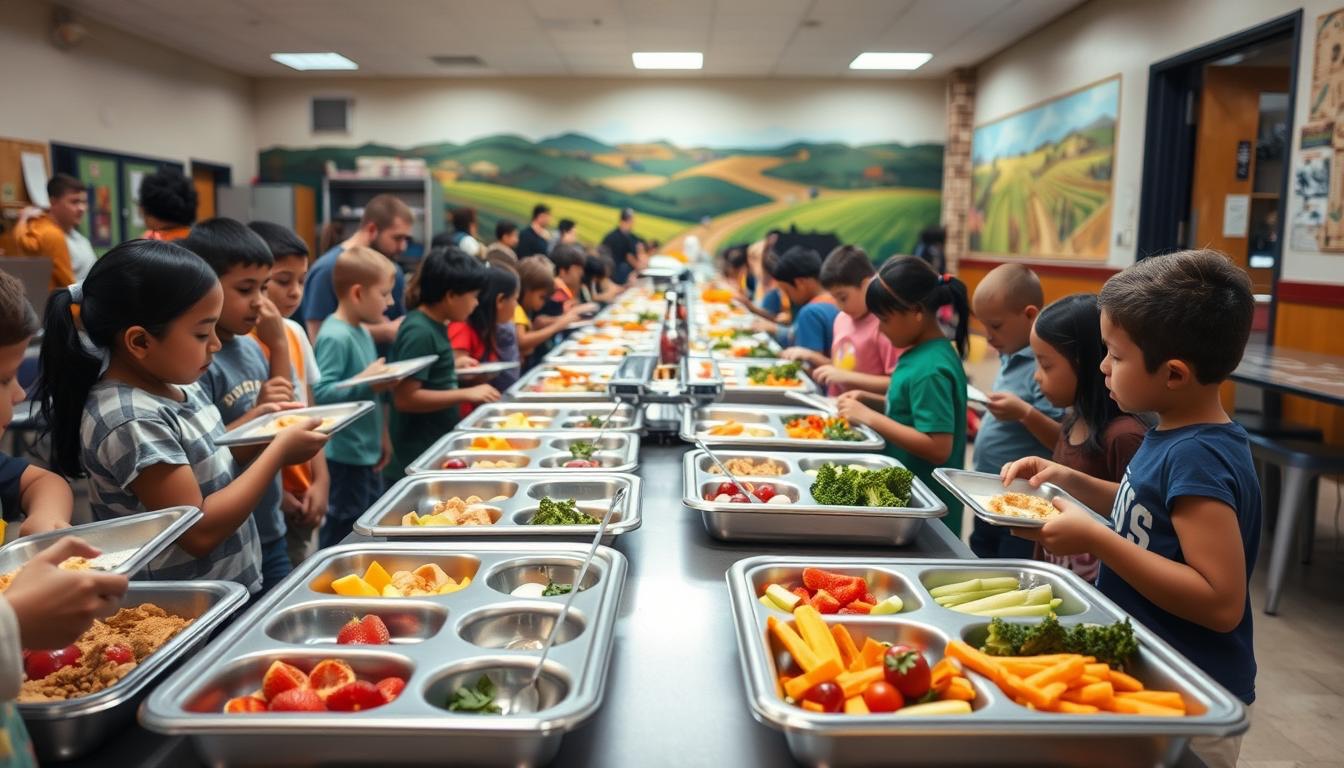Table of Contents
The U.S. Department of Agriculture has cut two big programs worth about $1 billion. These cuts will hit thousands of schools, food banks, and farms hard. Rural and low-income urban areas will lose key resources that helped with food and farming for years.
The first program helped schools with food and learning tools. The second supported American farmers and food networks. Both aimed to boost local food systems and help those in need get fresh, healthy food.
Schools are now trying to find money for the new school year. Food banks, already busy, will have to do more with less. Small farms, which rely on these programs, might find it hard to stay afloat without new help.

Key Takeaways
- USDA has cut two programs valued at approximately $1 billion
- School nutrition programs face immediate funding shortfalls
- Food distribution networks to vulnerable communities are compromised
- Small farm operations face increased financial pressure
- Rural and low-income urban areas will experience the greatest impact
Understanding the USDA Budget Reduction Decision
The USDA has made big cuts in its budget. This is one of the biggest reductions in federal spending on agriculture in a decade.
The leaders of the USDA said they needed to be fiscally responsible. They mentioned the growing national debt as a reason for these cuts.
Key Officials Behind the Decision
Secretary Thomas Wilson led the effort to cut the USDA budget. He worked with Deputy Secretary Andrea Martinez and Budget Director Robert Patel. They got support from some members of Congress, like Chairperson Elizabeth Dunham.
Dunham said the cuts were necessary for fiscal restraint. The Office of Management and Budget helped finalize the cuts. White House economic advisors also gave input on which programs to target.
Timeline of the Budget Cut Announcement
The USDA started discussing budget cuts in January. By March, they had proposals ready for department heads. Then, on April 15th, they made the big announcement.
On April 22nd, the USDA released all the details.
Initial Public Response to the Cuts
Farm groups quickly spoke out against the cuts. The National Family Farm Coalition called them devastating. They said rural communities were already struggling.
Food security groups started a social media campaign. They used #ProtectFarmFunding and got a lot of support in just 48 hours.
Some state governors from agricultural areas plan to fight the cuts. They will use administrative channels to challenge the cuts.
Breaking Down the First Program and Its Community Impact
The Rural Community Development Initiative (RCDI) has been a lifeline for thousands of small towns across America. It helps communities build essential infrastructure and creates jobs. The federal programs reduction has targeted this vital support system that many citizens rely on daily.
Historical Background of the Program
Established in 1996, the RCDI focused on developing clean water access in farming communities. By 2005, it expanded to include healthcare facility development, transportation infrastructure, and digital connectivity projects. The program gained significant bipartisan support, helping over 4,300 communities revitalize their economic foundations.
Communities Most Dependent on Its Services
Rural regions with declining populations face the greatest impact from these cuts. Counties in Appalachia, the Mississippi Delta, and tribal lands have relied heavily on RCDI funding. The community services affected include small towns where program grants often represent the largest source of development capital.
| Region | Dependency Level | Primary Services Funded | Population Affected |
|---|---|---|---|
| Appalachian Counties | High | Healthcare facilities, broadband | 1.2 million |
| Mississippi Delta | Critical | Water infrastructure, job training | 850,000 |
| Tribal Lands | Severe | Transportation, healthcare access | 720,000 |
| Rural Midwest | Moderate | Agricultural innovation, broadband | 1.5 million |
The federal programs reduction means these communities will lose critical funding avenues. Rural hospitals that received operational grants face potential closures. This will force residents to travel hours for medical care. Water infrastructure projects in early planning stages will stall indefinitely. Many affected communities simply lack the tax base to replace these funds locally.
- Rural healthcare facility maintenance grants ($245 million)
- Clean water infrastructure projects ($180 million)
- Broadband expansion initiatives ($210 million)
- Small business development centers ($115 million)
- Technical assistance programs for local governments ($90 million)
Small town mayors across affected regions report the cuts will force difficult choices. They must decide between maintaining essential services and abandoning development plans. The ripple effects will extend beyond direct grant recipients to contract workers, suppliers, and local businesses that depend on these projects.

The Second Program’s Role in Supporting American Agriculture
It gave grants, technical help, and low-interest loans to farms struggling against big corporations.
Last year, the program gave $425 million to over 2,300 farms in 47 states. This money helped update irrigation, build facilities, and connect farms to cities. It was a big help for rural areas.
Without this program, rural areas will miss out on important support. It helped farms and communities deal with market changes. It also funded offices that offered free soil tests and farming advice.
Without support, many farms might close. This could hurt local food systems, including farmers markets and farm-to-school programs.
How Local Schools and Food Banks Will Feel the Impact
The USDA budget cuts hit America’s food security hard. They cause big problems for schools and food banks across the country. Funding for important services is disappearing.
Nutritional Programs at Risk
Breakfast programs for 14 million kids are in danger. Summer meals for low-income students might see a 25% drop.
These programs do more than just feed kids. They are often the only reliable source of nutrition for many.
A bustling school cafeteria, with students eagerly lining up for their lunches. In the foreground, trays filled with a variety of nutritious options – fresh fruits, vegetables, and wholesome entrees. The lighting is warm and inviting, creating a sense of community and care. In the middle ground, school staff diligently monitor the serving lines, ensuring each child receives a balanced, nourishing meal. The background reveals a vibrant mural, depicting the local landscape and the importance of sustainable agriculture. The overall scene conveys the vital role that local schools play in providing accessible, high-quality nutrition programs that support the well-being of the entire community.
Educational Resources Being Reduced
Schools must cut programs that teach about food systems. Nutrition lessons that were free will now cost districts money.
School Administrators’ Reactions and Concerns
Districts with many students who get free or reduced lunches are the most concerned.
We’ve built trust with families who rely on these programs. Now we must tell them we can’t provide the same level of support when they need it most.
Food banks are facing big challenges too. 42% say they must cut back on how often they give out food. Rural areas expect to serve 35% fewer families, while cities face more demand but less food.
This creates a tough situation for communities already struggling with hunger.
- 76% of surveyed districts report no contingency funding
- Food banks estimate a 3.4 million pound reduction in available food
- Nine states have initiated emergency response planning
- Volunteer recruitment increased 22% as organizations seek alternative support
American Farmers: The Overlooked Victims of the Budget Cuts
American farmers are facing big challenges due to the USDA cutting two important programs. These cuts hurt rural America, threatening the livelihoods of many. These jobs have supported communities for generations.
Small Farm Operations Most Vulnerable
Family farms with less than 50 acres are losing vital subsidies. These subsidies helped them deal with market ups and downs. Without them, small farms are at risk of failing.
A dairy farmer in Wisconsin said his farm might not make it without these programs. His farm has been in the family for three generations.
Agricultural Communities’ Economic Outlook
Rural towns that rely on farming are feeling the effects of farm income drops. Local businesses like equipment dealers and seed suppliers expect to lose 15-20% of their revenue. This decline affects everything from schools to healthcare.
Farmer Advocacy Group Responses
The National Family Farm Coalition is urging members to speak out to lawmakers. They’re holding virtual town halls to show the impact of these cuts. Farm Aid says every dollar cut from these programs costs rural economies about four dollars.
The American Farm Bureau Federation calls the cuts short-sighted. They worry about the impact on food security and local farming.
The Federal Reasoning Behind the Program Reductions
The Department of Agriculture says it’s cutting budgets for fiscal reasons. It has a $32 billion deficit, leading to tough choices in many programs. Agriculture Secretary Tom Vilsack called these cuts “strategic realignments,” not eliminations, in a recent briefing.
A stack of government documents labeled “USDA Budget Cuts” sits on a wooden desk, illuminated by warm, directional lighting. The documents appear crisp and official, with various charts, graphs, and stamps visible. The overall mood is serious and business-like, reflecting the gravity of the budget cuts and their potential impact on local communities.
Three main reasons are behind these cuts, say budget analysts. First, they want to focus more on climate-smart agriculture. Second, they see program overlap that wastes resources. Third, they aim to make delivery systems more efficient to save money.
“These difficult decisions reflect our commitment to responsible stewardship of taxpayer dollars while protecting our core mission of food security and rural prosperity,” stated Deputy Secretary Jewel Bronaugh in the official announcement.
Some say these cuts hurt vulnerable communities. Others believe they will help in the long run.
Congress wants to know more about these cuts. They’ve asked the USDA for detailed reports. This might mean more checks before the cuts go through next year.
State and Local Responses and What Citizens Can Do
Across America, communities are stepping up after the USDA cuts. They are acting fast to help local schools and food banks.
Innovative Approaches Some Communities Are Trying
Some school districts are working with local farms. They offer programs with cheap produce for students. In Michigan, a group of businesses is matching donations to help food banks.
Limitations of State-Level Solutions
State budgets can’t fully replace federal funds. Rural areas have fewer resources to deal with food bank needs. States can only cover 30-40% of lost federal support, leaving big gaps.
Advocacy Channels Worth Pursuing
Citizens can make a difference in several ways:
- Contacting representatives through Feeding America’s action portal
- Volunteering at schools to support nutrition programs
- Donating to local food banks facing increased demand
- Attending school board meetings to voice concerns about local schools impact
- Participating in upcoming Farm Bill discussions at town halls
Public input is very important to lawmakers. Communities that act early can keep important services going with fundraising and volunteers.
Long-Term Consequences for American Food Security and Moving Forward
The budget cuts to USDA programs are a big worry. They show a shift in what the government values. This could hurt our food security a lot.
By cutting support for school meals and farmers, the government is weakening our food system. This could make it harder for poor families and small farmers to get good food.
Experts say these cuts could hurt family farms and local food banks. They also worry about the future of teaching sustainable farming. But, some places are finding new ways to help.
We need to keep an eye on this and fight for better food policies. We can do this by talking to our local leaders, supporting local projects, and pushing our politicians to act. Together, we can make sure our food system stays strong and healthy.
FAQ
What is the impact of the USDA’s decision to cut two programs worth roughly $1 billion?
The USDA’s decision to cut two big programs worth about $1 billion will affect many places. This includes local schools, food banks, and farms across the country.
Who were the key officials behind the decision to cut these USDA programs?
Top leaders at the USDA made the decision to cut these programs. This includes the USDA Secretary and other high-ranking officials. The timing and initial reactions to these cuts are also key to understanding the situation.

How did the second program support American agriculture?
The second program helped American farmers and rural areas a lot. It supported them through direct payments, subsidies, and more. It’s key to keeping farming sustainable and productive.
Cutting these programs will hurt schools and food banks a lot. They might lose important nutrition programs and resources. Food banks could struggle to help their communities.
What is the federal government’s reasoning behind these USDA program reductions?
The USDA says they cut programs for budget reasons and policy changes. But, people disagree on these reasons. Both supporters and critics have their own views.
How are state and local communities responding to fill the gaps left by these federal cuts?
Communities are finding new ways to keep services going despite less money. But, they face big challenges. People can help by supporting local groups, volunteering, or joining advocacy efforts.
What are the long-term consequences of these USDA program cuts for American food security and the future of agriculture?
Cutting these programs could harm food security and farming for years. Experts debate if it’s a short-term problem or a big change in policy. Advocacy efforts aim to fix funding or find new ways to support farming and food.